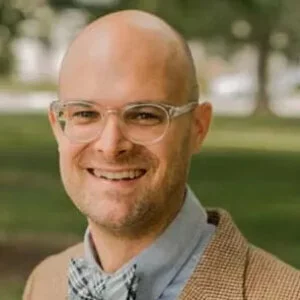As reflected in the two parts of her book, Sarah Lane Ritchie’s project is twofold. She first critiques the “standard divine action model,” which she grounds in the Divine Action Project (p. 7). According to such models:
- God doesn’t intervene, and so doesn’t go against natural processes or the laws of nature. Rather, God acts in ways consistent with the physical activities revealed by science.
- Divine activity can be categorized as general (i.e., regular and sustaining), special (i.e., non-regular and specific), or as miracles.
- For there to be non-intervening specific divine activities in the universe, there cannot “be a [complete] natural, physical explanation” for some things. In this sense, special divine activities are incompatible with physical activities (pp. 7-12).
As Ritchie observes, these commitments lead proponents of standard models to search for “causal joints”—places where specific divine activity along with natural activity determine outcomes. Likewise, they lead to a focus on domains of apparent physical indeterminacy; importantly, including quantum mechanics and the mind (pp. 43, 68–77; ch. 3).
In reply, Ritchie argues that to think that God:
- either does or doesn’t intervene in the universe,
- acts through special activities, “outside” of “normal” or general activities, and
- acts in ways that are compatible or incompatible with physical activities and laws of nature,
is to implicitly assume a view of nature as “self-sufficient and autonomous by default,” apart “from God’s ongoing, active presence” (pp. 78, 25). The implication is that standard models assume a metaphysical framework disparate from traditional, or orthodox, Christian metaphysics. They assume something akin to deism. Not only this, when we get into the details, we see these models aren’t plausible (pp. 12, 66–77). The central reason is that they lead to a search for apparent physical indeterminacies as loci of special providence. They lead to a search for “gaps.” This begs the question as to whether these models are merely an attempt to preserve the idea that God acts in specific and intentional ways in the face of growing scientific evidence to the contrary. Further, according to Ritchie, standard models go against the causal closure principle, defined as “the idea that all physical events have physical causes”; or “put conversely, no nonphysical causes can cause events in the natural world” (pp. 37–38). The problem is—again, according to Ritchie—this principle is “a methodological assumption of science,” and supported by scientific advancement (e.g., p. 38). To add to these problems, standard models would seem to pigeonhole divine activity. So, in sum, standard models have a “causal joint problem.”
A ‘Theological Turning’ of ‘Causal Joints’
The second part of Ritchie’s project is to develop the contours of a different approach to divine action—an approach that takes fully and seriously, not only God’s transcendence, but also God’s immanence. According to this approach, laws of nature are consistently understood to be descriptive of physical regularities (cf. pp. 47–54). Also, nature isn’t, at any moment, self-sufficient or autonomous. God is—at all times—intimately and actively “present,” “participatory,” and “involved with nature” and natural processes (p. 78). Thus, to be “natural” in the fullest sense is to depend on, and participate in, God’s active and intimate presence (pp. 189–93). The implication is that “all of nature is a causal joint,” and so there is no substantive distinction between general and special divine activities (p. 193).
In short, Ritchie advocates for:
- rejecting nonintervention/intervention language when talking about divine activity;
- rejecting the distinction between general and special divine activities; and
- compatibilism between divine activities and physical activities.
And she argues that making this “theological turn” is taking seriously traditional, and orthodox, Christian metaphysics concerning the presence and activity of the Creator in creation.
I find Ritchie’s central critique of standard models compelling. I agree that a different approach is needed—one grounded in robust Christian theological understandings of God’s immanence, intimacy, and participation in creation. However, I wonder whether she’s dug deep enough to extract the roots of the problem in our modern tendencies of thought—tendencies that may interfere with clear thinking about how such a Creator can be active in a way that gives forth to the activities of creatures (cf. p. 32). Central questions remain concerning concepts such as mind and causation. Related questions also remain concerning how we should define ‘physical’ and the domain of science. I believe Ritchie’s focus on these, and related, topics helps bring into focus what is needed for a sound theology of divine action. But I also agree with her assessment at the end of the book that a “causal joint problem remains” (p. 349). And I think a way of resolving this problem runs through a thorough analysis of these sorts of concepts. Let me illustrate by addressing Ritchie’s treatment of the mind and physicality.
Physicality and the Mind
Ritchie maintains that it is a “common assumption (even in science and religion) that the mind is something more than the brain, and that this is a theologically necessary feature of reality” (p. 14). As she observes, there is a “real and persistent theological resistance to the naturalization—let alone physicalization—of consciousness.”Ritchie maintains that it is a “common assumption (even in science and religion) that the mind is something “more than” the brain, and that this is a theologically necessary feature of reality.” As she sees it, this resistance is partially due to the influence of standard models where the mind serves as a pivotal “gap” for special providence. This is why she focuses so heavily on the mind in her book (see chs. 3–5). But, according to Ritchie, by letting go of standard models, we can embrace what she sees as “good philosophical and scientific support” for “the physicality of the embodied mind” (pp. 14–15). But what does she mean by “physicality”?
Ritchie uses “physical to denote those entities or phenomena that are explicable wholly in the terms of physics” (p. 135). Elsewhere, she says she uses “physical” in a “restrictive sense, excluding nonphysical entities” (p. 136); and she uses “physicalism” to “denote the position affirming only those entities and phenomena explicable in terms of energy, matter and the relationship between them (e.g., electrons, protons, neutrons, electromagneticism, gravity, etc.)” (p. 135). In this case, the “physicalization” of the mind, is a complete understanding of it in terms of the entities and phenomena studied in physics, without reference to anything else. Put succinctly, it’s the idea that “the mind is the brain,” or “the brain-body-environment system.”Presumably, Ritchie thinks brains and ‘brain-body-environment systems’ are explicable wholly in terms of the entities and phenomena studied in physics. The alternatives she has in mind are forms of dualism wherein the mind, or soul, is conceived of as an immaterial substance or entity (cf. p. 175).
There has, however, been sustained analytic work indicating that thinking the mind is a substance or entity at all—be it a brain, “brain-body-environment system,” or soul—is conceptually problematic.E.g., G. Ryle, The Concept of Mind (London: Hutchinson, 1949); P. Strawson, Individuals: An Essay in Descriptive Metaphysics (London: Methuen, 1959); A. Kenny, The Metaphysics of Mind (Oxford: Oxford University Press, 1989); M. R. Bennett and P. M. S. Hacker, Philosophical Foundations of Neuroscience (Oxford: Blackwell, 2003); E. J. Lowe, An Introduction to the Philosophy of Mind (Cambridge: Cambridge University Press: 2000); E. J. Lowe, Personal Agents: The Metaphysics of Mind and Action (Oxford: Oxford University Press, 2010). It’s to make what we might call a category mistake; mistaking characteristics and their expression for a possessor and expresser of those characteristics.
As Ritchie herself seems to suggest, when we talk about consciousness—at root—we refer to the active possession and/or expression of a host of capacities, abilities, or dispositions (cf. pp. 170–74).Though, perhaps more precisely, ‘to be conscious’ refers to either the state of being able to express these characteristics to their fullest extent, or to their actual expression while in this state. The same is true when we talk about the mind. We are, at root, referring to characteristics and their expression, which we categorize as ‘mental.’ To illustrate, when someone is ‘losing their mind,’ the mental characteristics they possess and/or express are changing; and to ‘have a mind of your own’ is to have a certain set of characteristics and express them in a certain way. To add to this, we learn to think and speak of the mental using predicates, which are parts of a sentence that modify subjects; e.g.—‘I am thinking’; ‘She sees the bird’; ‘He is empathetic.’ So, predicates are used to state something about a subject, such as a substance or entity.
The implication is, the conclusion that the mind is the brain—or is any physical or nonphysical substance or entity—involves mistaking what is, at root, said about or related to a subject for a subject.It is mistaking what we come to have a concept of using verbs and adjectives for what we come to have a concept of using nouns. We are, in effect, mistaking certain characteristics and their expression for a potential possessor and expresser of these characteristics. To say such things as ‘the mind is the brain’ doesn’t seem to be in keeping with the logic of the way we conventionally talk, think, or come to have a conception of the mental. And this is something to be established using methods other than those that ordinarily characterize rigorous science (cf. p. 151). Scientific methods are designed to uncover (at least aspects of) what is true about the universe. Analytic methods are designed to uncover what is logically possible or conceivable—what makes sense and could be true or false.
The observation that talk of the mind is, at root, talk of certain characteristics and their expression helps direct the question about the ‘physicalization’ of the mind. The question becomes whether this kind of characteristic can be equated with physical characteristics. And this is a question about the conceivability, or logical possibility, of ontological reduction; especially if we follow Ritchie and restrict our use of ‘physical’ to refer only to that which is studied in physics. It is also a question about the ascription of different kinds of characteristics.
If the criteria for ascription are identical between two characteristics, then so are the characteristics. They are, in essence, two different ways of picking out and referring to the same characteristic. So, if the criteria for ascribing mental characteristics are the same as ascribing certain physical characteristics, then they are, in essence, the same characteristics. The mental is ontologically reducible to the physical.
If, however, the criteria for ascription are distinct between two characteristics, the characteristics are distinct. The two are identified differently. At least analytically, or logically, they can come apart. Restated, it is conceivable, or logically possible, that we might find one of the characteristics without the other. And this may be true of two characteristics even though we might always find them together.The reason is what constitutes the expression of our mental characteristics is distinct from what constitutes the expression of physical characteristics. (Here, again, is that important distinction between what is logically possible and what we might find to be true in the universe.)
We may always find two distinct characteristics together due to some sort of causal relation between the two. But this can only be the case if the characteristics are not identical. And this illustrates why it is important to examine whether the criteria for ascribing two characteristics are, in essence, the same or distinct. It shows the importance of using analytic alongside scientific methods.
It seems clear that the criteria for ascribing mental characteristics (e.g., being able to be aware of or remember something) are distinct from the criteria for ascribing physical characteristics (e.g., being able to conduct electricity). This insight, after all, underlies anomalous monism (p. 101) and multiple realizability (pp. 167–68). That is, it underlies thinking that the expression of mental characteristics does not “fall under strict laws,”D. Davidson, “Psychology as Philosophy,” in S. Brown (ed.), Philosophy as Psychology (New York: Harper & Row, 1974), 43. and that very different entities can have the same mental characteristics.Cf. H. Putnam, Mind, Language, and Reality: Philosophical Papers, vol. 2 (Cambridge: Cambridge University Press, 1975). This insight also provides the basis for Wittgenstein’s intimation that it is imaginable that a person live a full and complete life, and we one day find their head is empty.L. Wittgenstein, On Certainty, trans. G. E. M. Anscombe and G. H. von Wright (Oxford: Blackwell, 1969), §4. His point isn’t that one day we might actually find someone like this. It is that the criteria for ascribing mental characteristics are distinct from the criteria for ascribing neurophysiological characteristics. The reason is what constitutes the expression of our mental characteristics (e.g., being aware of or remembering) is distinct from what constitutes the expression of physical characteristics (e.g., conducting electricity).
This brings us to a further insight concerning the ascription of mental characteristics. Not only are mental and physical characteristics distinct, meeting the criteria for being ascribed certain mental characteristics requires a certain kind of bodily existence. This is because we come by the concept of the mental—and are able to ascribe mental characteristics at all (including to ourselves)—by being able to ascribe this category of characteristic to living organisms on the basis of the expression of complex behaviors in relation to living and non-living things in the course of life. And we distinctively find the expression of some of these characteristics where we find a living person, in certain (conscious) states. In other words, at root, mental characteristics are ascribed to living organisms, and some are distinctly ascribed to persons. They are not ascribed to mere brains or bodies, which have different persistency conditions than a person.Cf. Lowe, 2000a, chs. 1–2. And this is the case even though persons are equally ascribed certain physical characteristics. Thus, not only do they have certain mental characteristics, they also have a certain kind of organic body made of living cells, and thus certain physical characteristics—including neurophysiological characteristics. Here, it is important to note that a person’s organic body is substantively different from the ‘bodies’ of inanimate, non-organic entities. In this case, just as it seems to go beyond empirical warrant (i.e., deduction or induction from observation) to say non-organic machines are alive, it seems unwarranted to extend the ascription of mental characteristics to such machines, other than analogically or metaphorically (cf. pp. 169–74).
What I have said to this point is grounded in the logic of the way we conventionally think and talk about, and come to have a concept of, the mental. It is based on analysis, not intuition (cf. p. 154). The upshot is it does not make sense to either identify (or ascribe) what we conventionally think of as mental characteristics with (or to) the brain, nervous system, or body. On the other hand, we do conventionally ascribe them to one with a brain, nervous system, and body—to a person and other living things.
The Empirical Warrant of Causal Closure Principles
It may, however, seem I have sidestepped what is at the root of ontological reductionism. What about causation? After all, Ritchie talks a lot about the causal closure principle. Isn’t there empirical warrant for thinking that—regardless to whom or what we may ascribe mental characteristics—all causal processes in the universe are ‘physical,’ in Ritchie’s reductionistic sense?Ritchie seems to think that, methodologically, science assumes a causal closure principle that is ontologically reductionistic, and that scientific advancement provides evidence for the truth of such a principle. And, in this case, isn’t Jaegwon Kim correct that either the mental is epiphenomenal or reducible to things studied in physics?J. Kim, Philosophy of Mind, 3rd ed. (Boulder, CO: Westview Press, 2010); cf. Ritchie 175–83. If we accept Ritchie’s definition of ‘physical,’ and that all causal processes in the universe are physical, Kim is correct. Nonreductive physicalism is a contradiction in terms. The first term refers to the position that there are more causes than those studied in physics, while the second refers to the position that there aren’t.
As I mentioned above, Ritchie seems to think that, methodologically, science assumes a causal closure principle that is ontologically reductionistic, and that scientific advancement provides evidence for the truth of such a principle. The problem is there isn’t one accepted monolithic causal closure principle.E. J. Lowe, “Causal Closure Principles and Emergentism,” Philosophy 75 (2000b), 571–85. Ritchie herself offers two different versions.
If you recall, Ritchie first says that the causal closure principle is “the idea that all physical events have physical causes.” And interestingly—even if we accept her restrictive definition of ‘physical’—this idea is compatible with the idea that people cause change by expressing distinctive mental abilities. To illustrate, given this principle, when one chooses to raise one’s arm, at every point in time from the beginning of the universe leading to muscle contractions in one’s arm, there may be ‘physical’ causes for this event. Yet, at least some of these ‘physical’ causes might not be sufficient causes in such a way that had one not chosen to raise one’s arm (and thereby expressed a distinctive mental causal ability), these muscle contractions would not have occurred.Cf. Lowe, 2000b.
However, Ritchie then says that, “put conversely,” the causal closure principle is the idea that “no nonphysical causes can cause events in the natural world.” But this is not the converse of her first definition. According to this version, all causes in the natural world are ‘physical.’ And thus—given her restrictive definition of ‘physical’ and ‘nonphysical’—this version is incompatible with the idea that a person causes change by expressing distinctive mental abilities. The reason is—even if a person is a physical entity in that they have physical characteristics—to be ‘physical’ in Ritchie’s sense is to be an entity or phenomena studied in physics (e.g., atoms, atomic force, gravity, electromagnetism). In this case, the only way a person might cause events in the natural world, like muscle contractions, would be by being identified with or identical to causes expressing causal abilities studied in physics. Not by expressing distinctive causal mental abilities.
So there are multiple versions of the causal closure principle. And only some are incompatible with the idea that people cause change by expressing distinctive mental abilities. Further, as Lowe has extensively argued, it seems that only unwarranted versions of the causal closure principle might cause problems for the idea we express distinctive causal mental abilities.Lowe, 2000b; 2010. And I should mention that—given Ritchie’s definition of ‘physical’—such versions would be equally incompatible with the idea there are distinctive chemical, biological, or sociological causes. Moreover, I can’t see how scientific methodologies would require the assumption of such a principle. As far as I can tell, the most that is assumed by empirical methods is that, under certain clearly defined conditions, there are regular causes for events in the universe, which can be isolated by physical characteristics. So it seems neither Ritchie’s restrictive conception of ‘physical,’ nor that the causes isolated are sufficient, need be assumed.
Sifting Metaphysics from Physics
My overarching point is that there seems to be a reductive metaphysical framework embedded in the version of physicalism Ritchie seems ready to adopt. Not only does this framework extend beyond empirical warrant, it also seems to extend beyond anything testable or falsifiable using scientific methods. Thus, while I agree with her that standard divine action models assume metaphysical frameworks that “disenchant nature,” I wonder if she has too.I enthusiastically follow Ritchie in her effort to recover a deep theological basis for a metaphysics of divine action. Without resorting to immaterial substances, the universe seems more diverse, multifarious, teeming, and “dappled”Cf. N. Cartwright, A Dappled World: A Study of the Boundaries of Science (Cambridge: Cambridge University Press, 1999). with various kinds of entities, substances, characteristics, conditions, and causes than the physicalism she seems happy with admits.
I’m sympathetic with her skepticism of standard divine action models, which seem to need the mind to be an immaterial substance. But I am equally skeptical of the physicalism she thinks is viable, which seems to need the mind to be reduced to the things studied in physics. While I can only hope to have traced my reasoning here, I believe both are likely grounded in a conceptually problematic metaphysics that find their sources outside empirical warrant, and outside a “theological turn” toward a robust Christian metaphysics.
I enthusiastically follow Ritchie in her effort to recover a deep theological basis for a metaphysics of divine action. I just question whether she has dug deep enough to completely root out competing metaphysics, or fully parsed out the capacities and limits of science to inform metaphysical frameworks. This being said, she has begun the sort of work I believe needs to be done for “the causal joint problem” to be properly addressed. And I wonder whether—as this work continues—we might come to find that the multifarious nature of causes and causation makes Thomistic ideas about God as primary cause more promising than she seems to think (cf. p. 246). Nevertheless, I imagine that, in both our science and theology, rediscovering just how ‘enchanted’ nature—or, even better, creation—is will require the continued cultivation of humility, wonder, patience, and attentiveness. This, I believe, will require recognizing how much is contingent (or simply given), and where our understanding and knowledge ends at any given moment. Providentially, this sort of approach has a long history in Christian theology, as it has informed traditions of Christian mysticism and spirituality characterized by an openness to the mystery of God’s intimate, active, and loving presence both unmediated and in and through all creation.








Comments
Be the first one to make a comment!